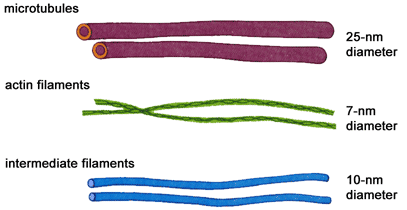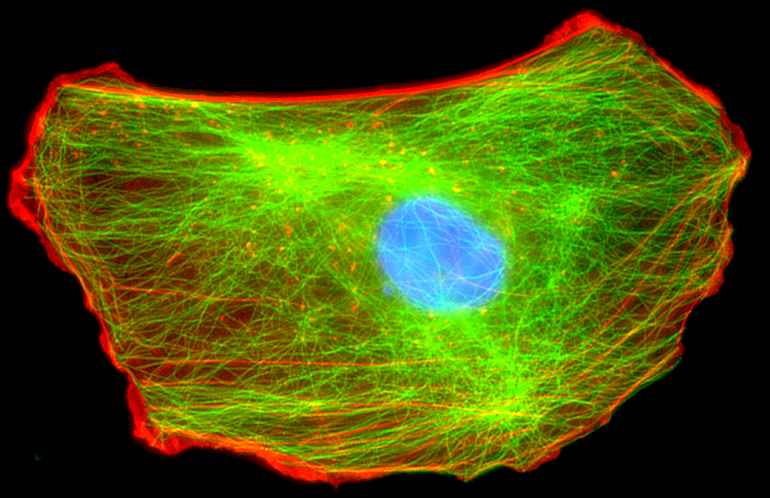Description
The cytoskeleton is an important part of all living cell. As the name suggests they somehow play the role of the skeleton in cells. In fact they are much more than that as they contribute actively to the displacement of cells as well has transmitting stress information from the cell membrane to the nucleus and also to the transport of material within the cell.
The cytoskeleton is made out of 3 different structures: the microtubules, the actin filaments and the intermediate filaments. They are all organic polymers made out of the assembly of proteins (tubulin for microtubule, actin for actin filament and other proteins like Vimentin and Keratin for intermediate filaments).
Each of these polymers have a different structure and exhibit dynamical properties which are essential to the cell metabolism. Microtubules, in particular, have a very rich dynamic property, called dynamics instability, that is essential for cell division, so much so that one of the anti-cancer drug, Taxol, works by modifying the dynamical properties of microtubules.
To study the cytoskeleton, Biologists needs the models derived by applied mathematicians. This is the best way to extract a maximum of information from experimental data.
Mathematically, these models are described by finite difference or differential
equations. The simplest models can be solved analyticity, the the most
realistic ones need to be solved numerically, making used of the so called
Monte-Carlo simulations.

The structure of cytoskeleton components.
 The cytoskeleton in the cell : actin filament in red and microtubules in green.
The cytoskeleton in the cell : actin filament in red and microtubules in green.
The Project
The project will start by learning what the cytoskeleton is and what its various role are. There will be some amount of biology involved. You will then study some aspect of the modelling of microtubules, actin filaments and intermediate filaments. This is described in several research papers. Finally you will be focusing on one very specific aspect of the modelling, and for this you will most probably have to write some computing code in a language like python, C++ or C.I will accept up to 4 students on this project.
Prerequisites
- No prerequisites as such but some knowledge of a computer programming language like python or C++ is desirable
Resources
- Cell Biology (2007) Thomas D. Pollard MD and William C. Earnshaw (Saunders ISBN-13: 978-1416022558)
- T. Mitchison and M. Kirschner. Dynamic instability of microtubule growth. Nature 312 237-242 (1984)
- Cytoskeleton movies
- T. Antal, P. L. Krapivsky, S. Redner, M. Mailman and B. Chakraborty. Dynamics of Microtubule Growth and Catastrophe. Phys. Rev. E 76, 041907 (2007)
- Gillespie T.D. A general method for numerically simulating the stochastic time evaluation of coupled chemical reactions. J. Comput. Phys. 22:403-434.(1976)